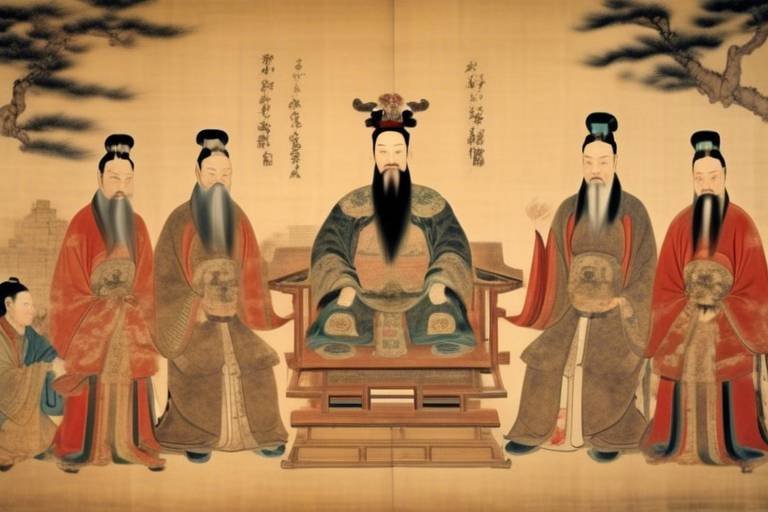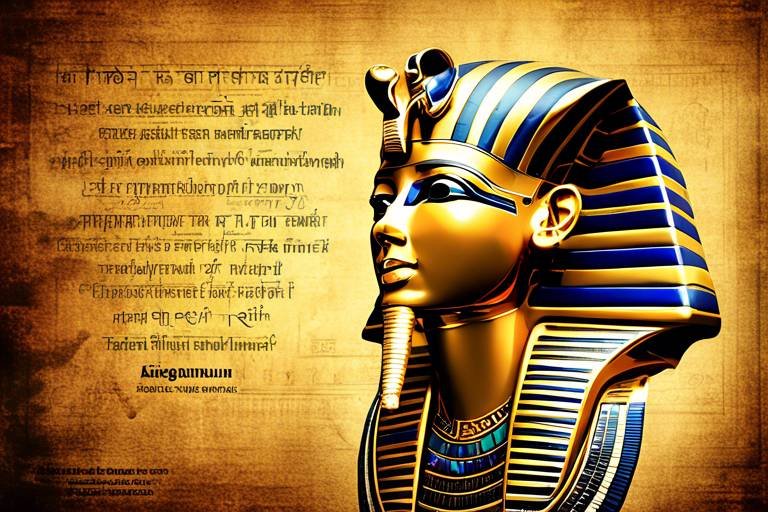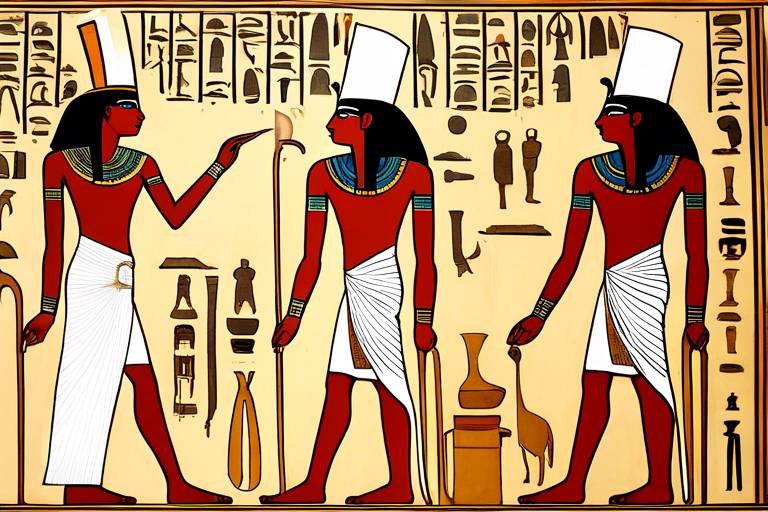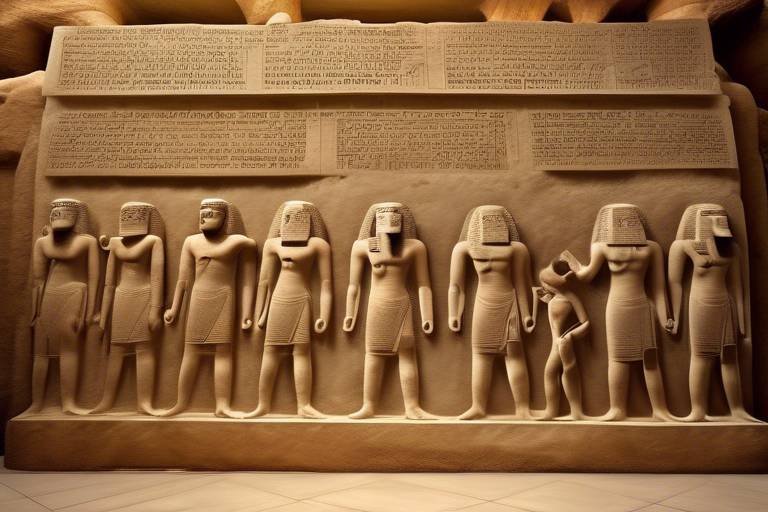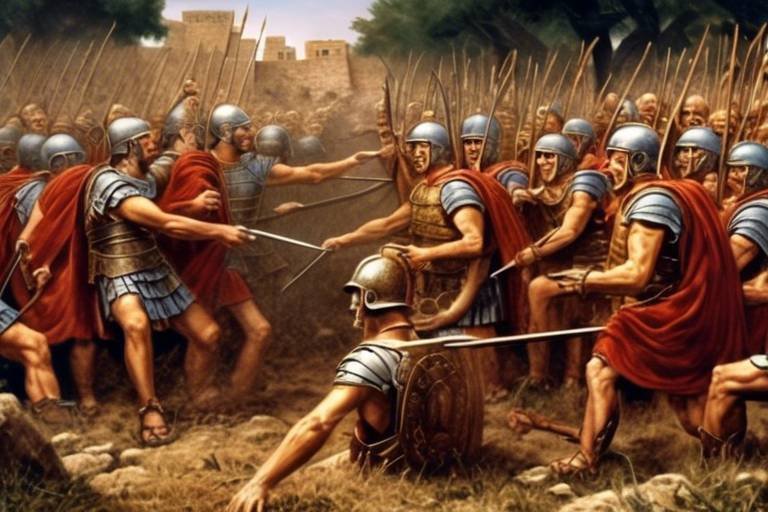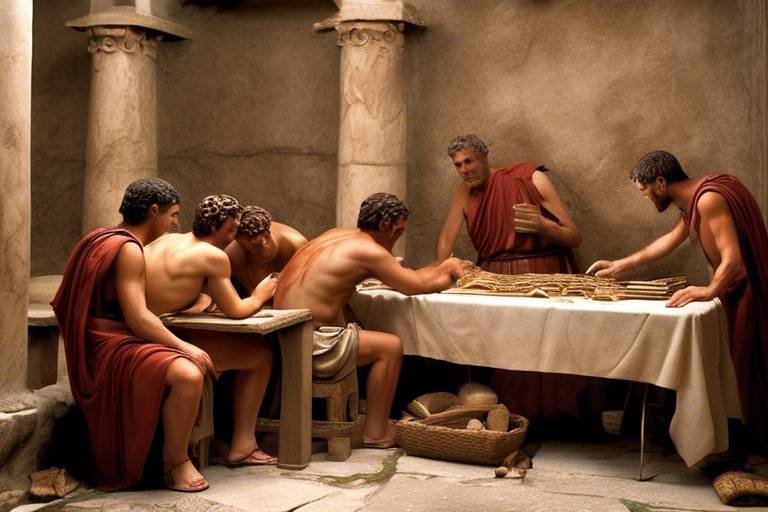The Mystery of the Ancient Chinese Emperors
Step into the intriguing world of ancient China, where emperors ruled with power and mystique, shaping the course of history with their enigmatic lives and legacies. These rulers, shrouded in mystery and surrounded by controversy, hold secrets, rituals, and tales that continue to captivate us today.
One of the most iconic figures in Chinese history is Emperor Qin Shi Huang, the first emperor to unify China. His reign was marked by grandeur and ambition, seen through the vast terracotta army guarding his tomb and the monumental construction of the Great Wall. Yet, behind these feats lay a quest for immortality that drove his rule to unprecedented heights.
Empress Wu Zetian stands out as the sole female emperor in Chinese history, a figure of political intrigue and cultural influence. Her rise to power was met with skepticism and awe, as she navigated the complexities of court life with unparalleled savvy, leaving a lasting mark on the empire.
Emperor Hongwu of the Ming Dynasty, a military genius and visionary leader, laid the foundations for a prosperous era in Chinese history. His administrative reforms and strategic acumen shaped the empire's trajectory, leaving a legacy that endures to this day.
Emperor Kangxi of the Qing Dynasty, known for his diplomatic prowess and cultural patronage, reigned over a vast and diverse empire with complexity and nuance. His rule, marked by both stability and challenges, remains a testament to the intricacies of imperial governance.
Emperor Taizong of the Tang Dynasty, revered for his wisdom and effective governance, led China through a period of military conquests and cultural advancements. His reign symbolizes a golden age of prosperity and innovation in ancient China.
Emperor Han Wudi, with his expansionist policies and embrace of Confucian ideals, ushered in a golden age for the Han Dynasty. His institutional innovations and cultural advancements laid the groundwork for centuries of prosperity and influence.
Emperor Kublai Khan, the Mongol ruler who established the Yuan Dynasty in China, sought to blend Chinese and Mongol cultures in a diverse empire. His legacy, marked by cultural exchange and imperial grandeur, remains a testament to the power of cross-cultural interactions.
Emperor Xuanzong of the Tang Dynasty presided over a prosperous yet tumultuous era, marked by military setbacks and cultural flourishing. His patronage of the arts and the challenges he faced during the An Lushan Rebellion paint a complex picture of imperial rule in ancient China.

Emperor Qin Shi Huang
Exploring the enigmatic lives and legacies of the rulers who shaped ancient China, uncovering secrets, rituals, and controversies surrounding their reigns.
Emperor Qin Shi Huang, the first emperor of a unified China, left a lasting mark on history with his ambitious endeavors and quest for immortality. His most famous legacy, the terracotta army, stands as a testament to his power and vision. Imagine thousands of life-sized soldiers and horses crafted to accompany him in the afterlife, a grandeur that echoes through the centuries.
Moreover, Emperor Qin Shi Huang's vision extended beyond the grave, quite literally, with the construction of the Great Wall of China. This monumental feat of engineering aimed to protect his empire from invasions and solidify his rule. The sheer scale and ingenuity of this ancient wonder continue to astound visitors to this day.
However, behind the grandeur and ambition lies a darker side to his reign. The emperor's relentless pursuit of immortality led to the infamous search for the elixir of life, resulting in the exploitation of his people and the poisoning of his own body. The price of eternal life, it seems, came at a high cost.

Empress Wu Zetian
Empress Wu Zetian, the remarkable figure in Chinese history, stands out as the only female emperor to ascend the throne. Her reign was marked by political intrigue, cultural advancements, and a controversial rise to power. Known for her exceptional political acumen, Empress Wu Zetian navigated the intricacies of the imperial court with finesse, consolidating her authority and leaving a lasting impact on Chinese history.
Empress Wu Zetian's legacy extends beyond her gender, as she made significant contributions to the arts and literature during her rule. She was a patron of the renowned poet Li Bai and fostered a flourishing cultural environment at the imperial court. Despite facing criticism and opposition, Empress Wu Zetian's support for the arts helped shape the cultural landscape of ancient China, leaving a lasting imprint on subsequent generations.
Moreover, Empress Wu Zetian's reign was not without controversy, as she employed ruthless tactics to maintain her grip on power. Her ascent to the throne involved intricate political maneuvering and the elimination of rivals, earning her a reputation for cunning and ambition. The mysteries surrounding her rule continue to intrigue historians, shedding light on the complexities of power dynamics in ancient China.
Empress Wu Zetian's leadership style and legacy have sparked debates among scholars, with some praising her as a trailblazer for women in leadership roles, while others criticize her methods as ruthless and authoritarian. By delving into the enigmatic life of Empress Wu Zetian, we uncover a multifaceted ruler whose impact reverberates through the annals of Chinese history, challenging traditional notions of power and gender roles.

Emperor Hongwu of the Ming Dynasty
Exploring the enigmatic lives and legacies of the rulers who shaped ancient China, uncovering secrets, rituals, and controversies surrounding their reigns.
Unveiling the first emperor of a unified China, his terracotta army, the Great Wall's construction, and the quest for immortality that defined his rule.
Delving into the controversial reign of the only female emperor in Chinese history, her political savvy, cultural contributions, and the intrigue surrounding her rise to power.
Emperor Hongwu, the founding emperor of the Ming Dynasty, rose to power with remarkable military prowess and implemented significant administrative reforms that left a lasting impact on Chinese history. His rule was characterized by a strict governance style, aimed at centralizing power and establishing stability in the empire. Hongwu's policies focused on agrarian reform, promoting agriculture to ensure food security and economic stability for his people. His dedication to effective governance and social welfare initiatives endeared him to his subjects, earning him a reputation as a ruler who prioritized the well-being of his empire.
Examining the longest-reigning emperor in Chinese history, his diplomatic achievements, cultural patronage, and the complexities of his rule during the Qing Dynasty.
Unraveling the military conquests, political reforms, and cultural advancements of one of China's most revered emperors, known for his wisdom and effective governance.
Investigating the expansionist policies, Confucian ideals, and institutional innovations of Emperor Han Wudi, whose reign marked a golden age of the Han Dynasty in ancient China.
Exploring the Mongol ruler who established the Yuan Dynasty in China, his efforts to blend Chinese and Mongol cultures, and the legacy of his diverse empire.
Examining the prosperous and tumultuous reign of Emperor Xuanzong, his patronage of the arts, military setbacks, and the An Lushan Rebellion that marred his rule.
Q: Who was the first emperor of a unified China?
A: The first emperor of a unified China was Emperor Qin Shi Huang, known for his terracotta army and the construction of the Great Wall.
Q: Which emperor is considered the longest-reigning in Chinese history?
A: Emperor Kangxi of the Qing Dynasty holds the title of the longest-reigning emperor in Chinese history.
Q: What were some of the key achievements of Emperor Han Wudi?
A: Emperor Han Wudi is known for his expansionist policies, promotion of Confucian ideals, and institutional innovations that marked a golden age of the Han Dynasty.

Emperor Kangxi of the Qing Dynasty
Emperor Kangxi, the fourth emperor of the Qing Dynasty, reigned for an astonishing 61 years, making him the longest-reigning emperor in Chinese history. His rule was marked by a series of diplomatic achievements that solidified Qing China's power on the global stage. Kangxi's ability to navigate complex political landscapes and establish strong relationships with neighboring countries ensured stability and prosperity during his reign.
One of the key aspects of Emperor Kangxi's rule was his deep commitment to cultural patronage. He was a great supporter of the arts, literature, and scholarship, leading to a flourishing of creativity and intellectual pursuits during his era. Kangxi's appreciation for culture not only enriched the lives of his subjects but also enhanced China's reputation as a center of artistic and intellectual excellence.
Despite his many successes, Emperor Kangxi faced numerous challenges during his reign. The complexities of governing a vast empire with diverse ethnic groups and cultural traditions required a delicate balance of power and diplomacy. Kangxi's ability to navigate these challenges with wisdom and foresight cemented his legacy as one of China's most respected emperors.
One of the most notable events during Kangxi's reign was the Revolt of the Three Feudatories, a rebellion led by three powerful Qing generals. The emperor's strategic military decisions and skilled leadership ultimately quelled the rebellion, showcasing his prowess as a military commander and a unifier of the realm.
Emperor Kangxi's reign left a lasting impact on Chinese history, shaping the foundation of the Qing Dynasty and influencing generations to come. His legacy as a wise and benevolent ruler continues to be celebrated in Chinese culture, embodying the ideals of good governance and leadership.

Emperor Taizong of the Tang Dynasty
Emperor Taizong of the Tang Dynasty, also known as Li Shimin, ascended to the throne in 626 AD after a tumultuous power struggle within the royal family. Taizong's reign is often regarded as a golden age in Chinese history, characterized by military conquests, political reforms, and cultural advancements that laid the foundation for the prosperity of the Tang Dynasty.
One of Emperor Taizong's most significant achievements was his military prowess, leading successful campaigns that expanded the empire's borders and secured its dominance in Central Asia. Taizong's strategic brilliance and leadership on the battlefield earned him a reputation as a formidable warrior-emperor, revered by his subjects and feared by his enemies.
In addition to his military conquests, Emperor Taizong implemented a series of political reforms aimed at strengthening the central government and promoting efficient governance. He established a merit-based system for selecting officials, emphasizing talent and integrity over noble birth, which contributed to the stability and effectiveness of the Tang administration.
Furthermore, Taizong's patronage of the arts and promotion of cultural exchange fostered a vibrant intellectual and artistic environment during his reign. The Tang Dynasty flourished under his rule, with advancements in poetry, painting, music, and calligraphy reflecting the sophistication and creativity of Chinese civilization.
Emperor Taizong's legacy as a wise and effective ruler endures in Chinese history, symbolizing the pinnacle of imperial power and governance during the Tang Dynasty. His reign exemplifies the blend of military strength, political acumen, and cultural patronage that defined the greatness of ancient Chinese emperors.

Emperor Han Wudi
Emperor Han Wudi, also known as Emperor Wu of Han, ascended to the throne in 141 BC and reigned over the Han Dynasty for over five decades, marking a significant period of expansion and innovation in ancient China. His reign was characterized by ambitious military campaigns that extended the empire's borders, solidifying Han China as a dominant power in East Asia.
One of Emperor Han Wudi's most notable achievements was the implementation of Confucian ideology as the state philosophy, emphasizing the importance of ethical governance and social harmony. This led to the establishment of a centralized bureaucratic system that promoted meritocracy and intellectual pursuits, laying the foundation for a golden age of cultural and intellectual flourishing.
During his rule, Emperor Han Wudi also spearheaded significant institutional reforms, including the introduction of land redistribution policies to alleviate social inequality and promote agricultural productivity. These reforms not only strengthened the economy but also fostered social stability and prosperity throughout the empire.
Emperor Han Wudi's patronage of the arts and scholarship further enriched the cultural landscape of ancient China, supporting the development of literature, music, and philosophy. His court became a vibrant center of intellectual exchange, attracting scholars and artists from across the empire to contribute to the flourishing cultural scene.
Despite his achievements, Emperor Han Wudi's expansionist policies and military campaigns were not without controversy, leading to strained relations with neighboring states and internal dissent. The cost of maintaining a vast empire and sustaining continuous military expeditions put a significant strain on the empire's resources and population, leading to social unrest and economic challenges.
In conclusion, Emperor Han Wudi's reign left a lasting legacy on the history of ancient China, shaping the political, cultural, and intellectual landscape of the Han Dynasty. His commitment to Confucian ideals, administrative reforms, and cultural patronage propelled the empire to new heights of prosperity and influence, solidifying his place as one of the most revered emperors in Chinese history.

Emperor Kublai Khan
Emperor Kublai Khan, the formidable Mongol ruler, left an indelible mark on Chinese history with his establishment of the Yuan Dynasty. His reign was characterized by a unique blending of Chinese and Mongol cultures, fostering a diverse empire that showcased the richness of both worlds. Kublai Khan's vision extended beyond mere conquest, as he sought to create a harmonious society that embraced the strengths of each culture under his rule.
One of the most notable aspects of Kublai Khan's rule was his promotion of cultural exchange and integration. By embracing Chinese traditions and practices while maintaining Mongol identity, he created a dynamic environment where innovation and collaboration thrived. This cultural fusion not only enriched the empire but also paved the way for future dynasties to draw upon this legacy of diversity and inclusivity.
Moreover, Kublai Khan's legacy extended beyond his cultural policies to encompass his administrative reforms and governance strategies. He implemented a system of governance that combined elements of both Mongol and Chinese administrative practices, creating a robust framework that ensured stability and efficiency throughout his vast empire. His emphasis on meritocracy and talent recruitment led to a more inclusive government structure that valued competence over lineage.
Additionally, Kublai Khan's reign witnessed significant advancements in trade and commerce, facilitated by the establishment of the Silk Road as a key artery for economic exchange. This strategic focus on trade not only bolstered the empire's prosperity but also fostered connections with distant lands, opening up avenues for cultural exchange and diplomatic relations that transcended borders.
Despite his many achievements, Kublai Khan also faced challenges during his reign, including resistance from traditionalists and internal power struggles within his court. The complexities of ruling over a vast and diverse empire tested his leadership skills, requiring him to navigate political intrigue and maintain stability amidst competing interests.
In conclusion, Emperor Kublai Khan's legacy as a visionary leader who bridged cultural divides and fostered innovation remains a testament to his enduring impact on Chinese history. His legacy serves as a reminder of the power of inclusivity and collaboration in shaping a vibrant and dynamic society that transcends boundaries.

Emperor Xuanzong of the Tang Dynasty
Emperor Xuanzong of the Tang Dynasty, also known as Li Longji, ascended to the throne in 712 AD during the golden age of the Tang Dynasty. His reign was characterized by prosperity and cultural flourishing, earning him the title of the "Golden Age Emperor." Xuanzong was a great patron of the arts, supporting renowned poets like Li Bai and Du Fu, whose works are still celebrated today.
Despite his initial successes, Emperor Xuanzong faced significant challenges during his rule, most notably the devastating An Lushan Rebellion that erupted in 755 AD. The rebellion, led by the general An Lushan, plunged the Tang Dynasty into chaos, leading to widespread destruction and loss of life. It marked a turning point in Xuanzong's reign, tarnishing his legacy and weakening the empire.
One of the key aspects of Emperor Xuanzong's rule was his efforts to strengthen diplomatic ties with neighboring countries, particularly the Tibetan Empire. These diplomatic initiatives aimed to ensure stability along the borders and promote cultural exchange, fostering a sense of unity and cooperation in the region.
Emperor Xuanzong's reign also witnessed military setbacks, including conflicts with the Tibetan Empire and the Uighur Khaganate. These challenges tested the emperor's leadership and strategic acumen, highlighting the complex geopolitical landscape of the time.
Despite the turmoil and challenges faced during his reign, Emperor Xuanzong's legacy endures as a period of cultural richness and artistic achievement in Chinese history. His patronage of the arts, promotion of cultural exchange, and efforts to maintain stability in the face of adversity cement his place as a significant figure in the Tang Dynasty.
Frequently Asked Questions
- Who was the most influential ancient Chinese emperor?
While each emperor had a significant impact on Chinese history, Emperor Qin Shi Huang is often regarded as one of the most influential due to his unification of China and the construction of the Great Wall.
- What is the significance of Empress Wu Zetian in Chinese history?
Empress Wu Zetian holds a unique place as the only female emperor in Chinese history. Her political acumen and cultural contributions have sparked intrigue and controversy, making her reign a subject of historical fascination.
- How did Emperor Kangxi of the Qing Dynasty leave his mark on Chinese culture?
Emperor Kangxi's reign is known for his diplomatic achievements and cultural patronage, which contributed to the richness of Chinese art and literature during the Qing Dynasty.
- What set Emperor Taizong of the Tang Dynasty apart from other rulers?
Emperor Taizong's reputation for wisdom, military prowess, and effective governance distinguished him as one of the most revered emperors in Chinese history, leaving a lasting legacy of political and cultural advancements.
- How did Emperor Kublai Khan's rule impact the Yuan Dynasty?
Emperor Kublai Khan's efforts to blend Chinese and Mongol cultures shaped the diverse empire of the Yuan Dynasty, leaving a legacy of cultural exchange and imperial administration.

